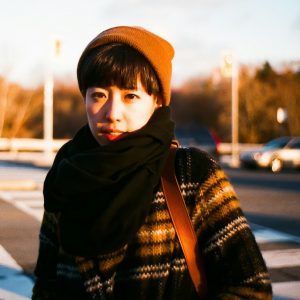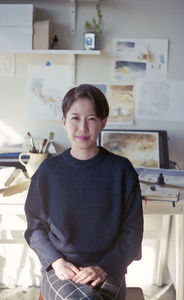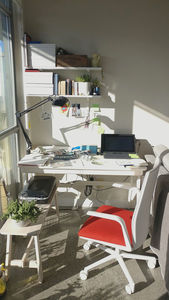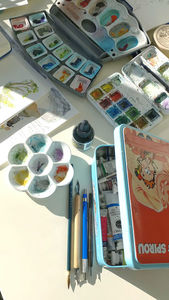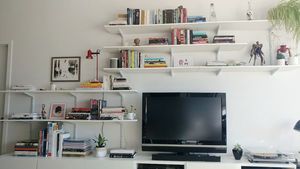Watercolour Illustrator Qin Leng Shares her Dreamy and Inspiring Workspace
Yesterday we introduced you to Jessica Scott Kerrin, author of The Better Tree Fort (Groundwood Books). Today, we are thrilled to welcome Qin Leng to Open Book, whose beautiful watercolour illustrations bring Kerrin's story to life in the funny and heartfelt tale about Russell, a boy who longs for a tree fort as impressive as the one down the street.
Leng's work as an illustrator has drawn widespread acclaim, and it's no surprise. Her work has been called "intricate" "fantastic" "eye-catching" "breathy" and "enchanting", and today we get to go behind the scenes into her airy condo workspace and see how these gorgeous images come to life.
Leng, who is also an award-winning filmmaker, tells us about losing her studio for a very good reason, how she makes a tiny workspace work for her, and the other illustrators whose work she turns to for a pick-me-up when she's in a slump. Don't miss the gorgeous photos of her inspiring workspace - you just might find yourself reaching for your own pencils and paints after this one.
___________________________________
At the Desk, with Qin Leng
I just relocated my little office nook from a private room in my condo, to the open space in my living room. You see, I just had a baby back in August, so my son sort of kicked me out of my workspace, as my husband and I had to turn my old studio into his bedroom.
So I am still in the process of organizing and getting the feel of this new workspace and trying to make it just right for me.
Because I draw very small, I really don’t need that large of an area to work. So my studio is this little table sandwiched between the living room couch and the balcony window.
The area consists of a desk obviously, a scanner propped up on a bench, and two shelves to store my work tools: inks, nibs, brushes, watercolour tubes, pencil crayons, paint tape, ink cleaners, and some of my watercolour paper and sketchbooks.
I also have a cintiq companion on my desk. I use this to layout the pages of my books or work out compositions for magazine covers and newspaper illos. But all my work is done traditionally: inked with a nib or brush on paper and painted with watercolors.
Aside from all this work equipment, I also decorated the area with some potted succulents. I always love to add little plants in scenes I illustrate, so it is important to have these organic elements in my work space as well.
Your CanLit News
Subscribe to Open Book’s newsletter to get local book events, literary content, writing tips, and more in your inbox
The wall my desk is propped up against is still pretty bare (at the moment, I only have a print from illustrator Ping Zhu), but I am planning on filling it with more references to keep the creative juices flowing. I just recently purchased some prints from Isabelle Arsenault and Patrick Doyon, so I am excited to put those up.
The relocation into my living room is actually a plus in many ways. For one, I get beautiful natural light. It is nice to be able to look up from my desk and take a break, enjoying the view from my balcony window.
Somehow being in an open space allows my brain to work freely. I wasn’t such a big fan of having to ‘go into my studio’ and close the door behind me. To have a closed off work area gave me an added pressure of having to ‘work’ and ‘produce’. It sometimes froze my capacity to create something freely.
The other advantage is that right behind me is now a wall of shelves filled with inspiring books of illustrators and photographers I love. I have a terribly inconvenient hobby (given that I live in a small condo with limited storage space) which is to buy, buy, buy, and buy books. There are simply too many incredibly talented artists out there and so I always find new picture books, graphic novels, art books I want to add to my collection.
So when I feel in a slump, I turn away from my drawing desk and walk over to my ever growing collection of books. Among my treasures are works by Jean-Jacques Sempé, Gabrielle Vincent, Jillian Tamaki, Sydney Smith, Isabelle Arsenault, Beatrice Allemagna, Nicolas de Crécy, Manuele Fior, Gipi, Carson Ellis….and the list goes on.
I find it important to pay attention to other people’s work, so that I never get too comfortable and stagnant in my own work.
I spent my early years as a child in France, so I never tire of some of the classics I grew up with: Le Petit Nicolas by Jean-Jacques Sempé, and the 1981 first edition of Ernest et Célestine by Gabrielle Vincent.
- Qin Leng, 2018
All photos credited to Lian Leng
___________________________________
Qin Leng lives and works as a designer and illustrator in Toronto. She graduated from the Mel Hoppenheim School of Cinema and has received many awards for her animated short films and artwork. Hana Hashimoto, Sixth Violin, written by Chieri Uegaki, was a finalist for the Governor General’s Literary Award, and received the APALA Award for best picture book. Her most recent books include Away, written by Emil Sher, and A Family Is a Family Is a Family, written by Sara O’Leary, which was selected for USBBY’s Outstanding International Books List.
